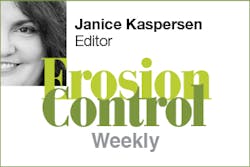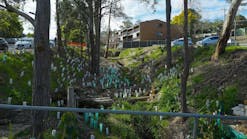
The county where I live—affected, like almost all of California, by the ongoing drought—has had a cloud-seeding program in effect since 1981. The technology has been around since the 1940s, although it was for years considered a questionable practice at best.
The idea is simple in theory. A chemical, most commonly silver iodide, is dispersed in the upper part of a cloud, either delivered by aircraft or fired from the ground. This causes some of the water vapor within the cloud to freeze; the tiny ice particles grow, collecting additional water vapor, until they become heavy enough to fall from the cloud as precipitation. It’s estimated that, during an average rainstorm, a cloud that has been seeded yields about 15% more rainfall than it otherwise would.
- BMP Case Studies
- Green Infrastructure
- Stormwater Program Management
- Advanced Research Topics
- Water-Quality Monitoring
- Industrial Stormwater Management
- Stormwater Management for Solid Waste Facilities
Santa Barbara County begins the process each year around November 1, except in particularly wet years. A meteorologist decides, before each forecasted storm, whether to seed, depending on things like current stream flow conditions. The program costs about $300,000 to $400,000 a year, with the costs split among the county, the cities, and water utilities.
This year, though, when rain is needed most, the process might not work as well. That’s because El Niño conditions are expected. Sea surface temperatures are higher than average over much of the Pacific Ocean, which generally leads to increased rainfall on land. But the clouds of the warmer El Niño storms are less susceptible to seeding than clouds under colder conditions.
About two dozen countries practice weather modification to some extent; countries occasionally complain that their neighbors have stolen rain that should have been rightfully theirs by seeding clouds.
Cloud seeding can be used to avoid rain where it isn’t wanted, too. During the 2008 Summer Olympics, officials in China—which has a large cloud-seeding program in place—reportedly seeded clouds before they could reach Beijing, so rain wouldn’t interfere with the opening and closing ceremonies.
StormCon Call for Papers Is Open
StormCon, the only North American event dedicated exclusively to stormwater and surface-water professionals, is seeking abstracts for presentation at StormCon 2016. The deadline for submitting abstracts is Wednesday, December 9.
The conference will be held in Indianapolis, IN, August 22–25, 2016. We are looking for abstracts in the following conference tracks:
- BMP Case Studies
- Green Infrastructure
- Stormwater Program Management
- Advanced Research Topics
- Water-Quality Monitoring
- Industrial Stormwater Management
- Stormwater Management for Solid Waste Facilities
For more information, including the complete call for papers and an online form for submitting your abstract, visit www.StormCon.com.
Upcoming Webinars from Forester University
October 21: “Maximizing Erosion Control With Proper Material Selection”
This free webinar takes place Wednesday, October 21. Click here for more information and registration.
November 11–December 18: “Sediment & Erosion Control for Roadway Projects” Master Class Series
Click here for more information and registration.
Janice Kaspersen
Janice Kaspersen is the former editor of Erosion Control and Stormwater magazines.





